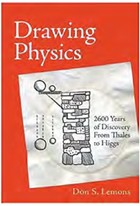In this little red book, Don S. Lemons has assembled a very useful and accessible collection of fifty-one physics concepts organized according to era and illustrated with drawings by Jesse Graber (as well as a few in Galileo’s own hand). One need not have a degree in a STEM field—or even a good grasp of high school physics—to understand the ideas outlined. Far from presenting dry formulas and math problems, Lemons uses simple drawings to walk readers through discoveries that have helped humans grasp how the world around them works. Lemons says the book is for readers “interested in the world in which they live but who, for various reasons, know little mathematics or physics.” Each section is a small, digestible vignette of several pages that can be read as a standalone explanation of a concept in physics. Due to this self-contained approach, there is, by necessity, a bit of repetition if you read the book straight through, as concepts are reviewed for an understanding of what comes next.
As the title states, the physics discoveries themselves are framed using drawings: not elaborate, comics-style panels or detailed technical illustrations but rather (as the cover implies) the scribbled-upon-napkin or back-of-the-envelope variety. The author explains how useful such “cartoon approximations” are in teaching otherwise complex ideas to students. He also paints a picture with words of how such images helped philosophers and scientists formulate their theories of the universe, taking us back to antiquity as a seventy-five-year-old Archimedes, drawing in the sand, yells out what turned out to be his last words, ordering a Roman soldier to “Stand back from my diagrams!” (30), or to seventeenth-century England, where an aloof and peculiar Isaac Newton sketched figures in the gravel walks of Trinity College (103). Drawings sometimes took the place of numbers, as with the electromagnetic discoveries of Michael Faraday, whose mathematical knowledge was not advanced enough to translate his ideas into formulas, but for whom “visualizations, of which the magnetic lines of force are a prime example, did the work of mathematics” (153).

Drawing Physics: 2,600 Years of Discovery from Thales to Higgs. By Don S. Lemons. The MIT Press, Cambridge, MA, 2017. ISBN: 978-0262035903. 246 pp. Hardcover, $27.
Leggete l'articolo completo e molti altri in questo numero di
Skeptical Inquirer
Opzioni di acquisto di seguito
Se il problema è vostro,
Accesso per leggere subito l'articolo completo.
Singolo numero digitale
September October 2017
Questo numero e altri numeri arretrati non sono inclusi in un nuovo
abbonamento. Gli abbonamenti comprendono l'ultimo numero regolare e i nuovi numeri pubblicati durante l'abbonamento. Skeptical Inquirer
Abbonamento digitale annuale
€19,99
fatturati annualmente